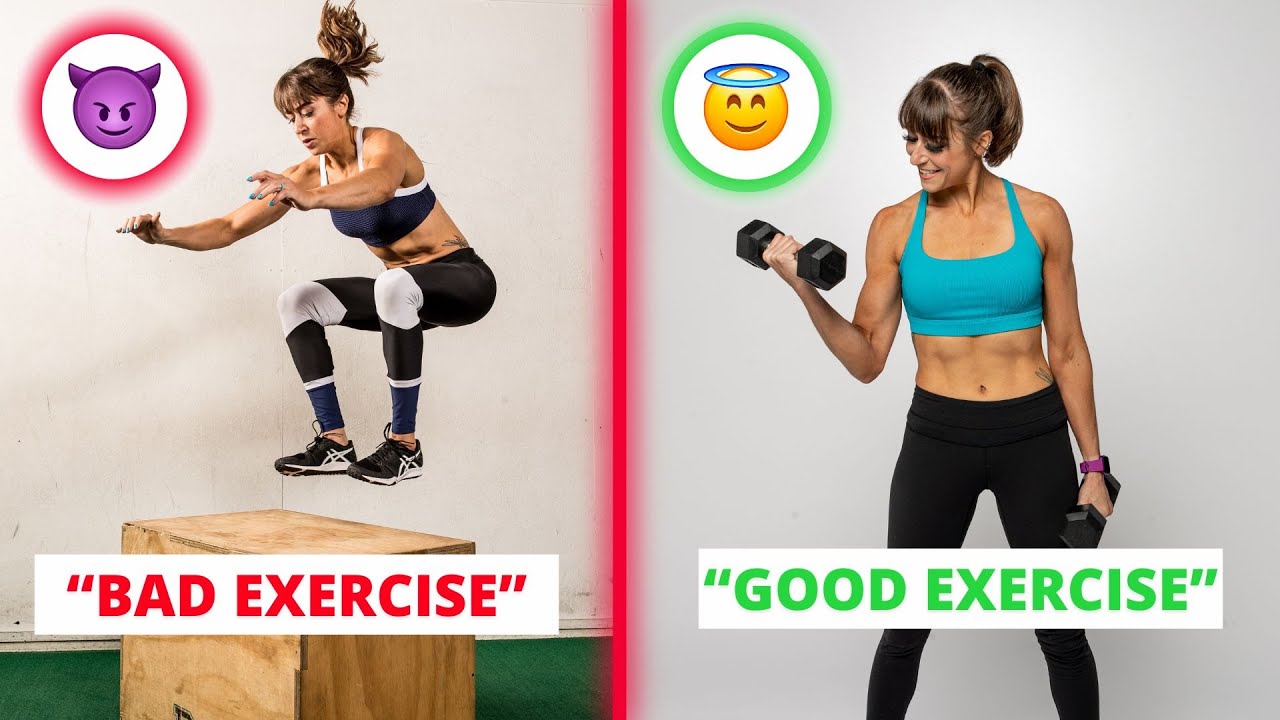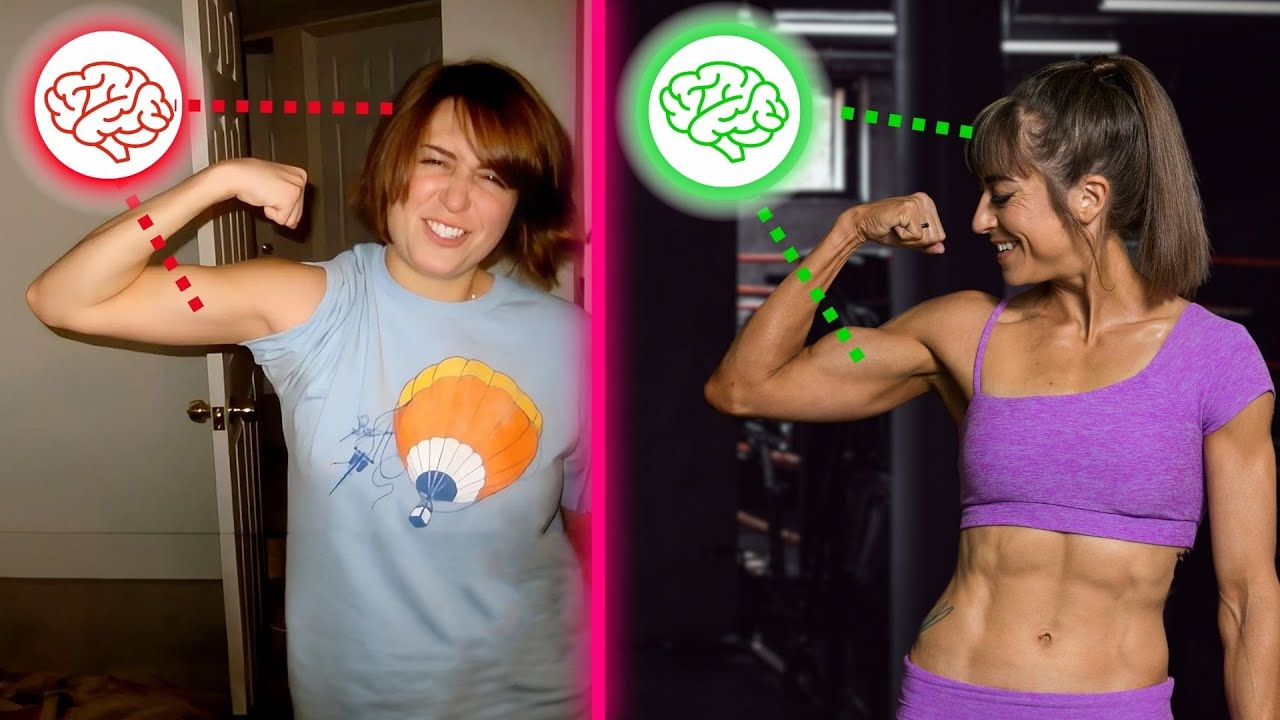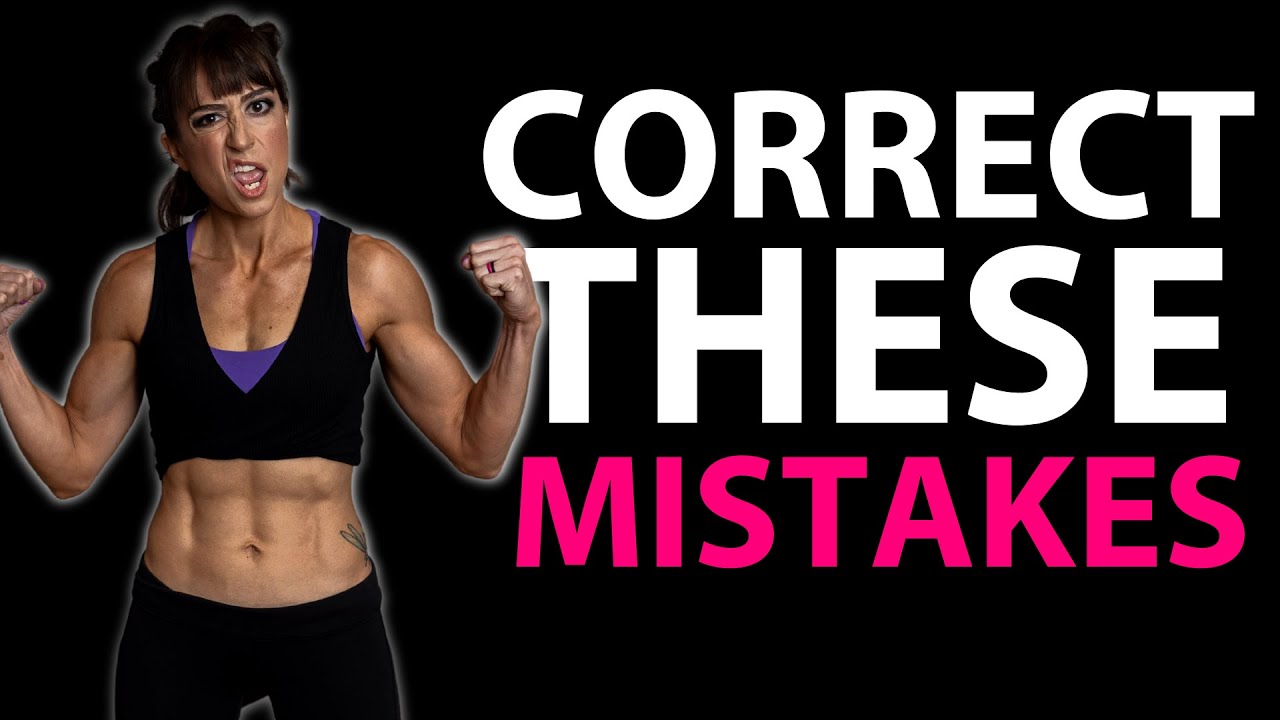
Stop Demonizing Exercises! 4 Myths DEBUNKED
The comment section can be…interesting to say the least.
If you spend too much time there, you’ll find out there is only one way to do every move…but no one truly agrees on what that one way is…
But everyone definitely has an opinion. And only THEIR way is the right one.
There are lots of things we’re told will basically destroy us if we do them.
Lots of moves that are demonized and blamed for aches and pains.
But honestly…there really are no “bad” moves…just improper usage and implementation of them.
So often we include moves not right for our specific needs or goals. Moves we haven’t earned.
And then we get injured doing them and demonize them…completely avoiding them.
But what we don’t realize is that by doing this, we put ourselves at greater risk for injury in every day life.
So many moves we do in the gym can be a great way to strengthen muscles and movement patterns essential for everyday life.
It’s why instead of simply avoiding moves, we need to regress to progress and learn to retrain as many movement patterns as possible.
We need to understand why aches and pains and the issues occurred in the first place to find variations of moves we can use to move and feel our best.
The gym should be a place to learn to move well and become functionally fitter so we can be strong and independent till our final day on this planet.
That’s why I want to address some exercises I see demonized and break down how to include them and retrain them, such as deadlifts being bad for your back or squats and lunges being bad for your knees…
Or even jumping and high impact being dangerous for us as we get older!
So first…

#1: Deadlifts Are Bad For Your Back.
Deadlifts are a weighted hip hinge often blamed for lower back pain.
But they are an essential movement pattern we need to all know how to control if we want to avoid throwing out our backs when lifting something up off the ground.
They are often blamed for lower back pain because we aren’t properly engaging our lats to support the weight as we use our glutes and hamstrings to drive the lift.
We aren’t properly bracing and recruiting muscles so our lower back becomes overworked and tries to carry more of the load to lift than it should.
Part of this tendency to overuse and recruit the muscles of our lower back instead of our glutes is due to the fact that far too many of us spend too much time seated at a computer or driving in a car.
Tight hip flexors can result in postural distortions that lead to underactive glutes and synergistic dominance of our hamstrings and anterior pelvic tilt. Which leads to our lower back wanting to work when it shouldn’t.
But it isn’t just tight hips that lead to lower back overload and changes in our recruitment patterns.
It’s also our hunched over posture that can perpetuate the issue.
When we don’t have proper thoracic extension, we are going to seek out mobility from other areas.
In trying to straighten our spine for deadlifts and press our chest out, we may notice we compensate by arching our lower backs. This arch may contribute to more anterior pelvic tilt and perpetuate us not only overusing our lower back but also our hamstrings over our glutes.
So it is key we note our daily postures to address in our mobility work before we needed so we can better activate the correct muscles.
But this is also why we have to notice we are simply leaning forward and not correctly pushing our butt back as we hinge.
And we may especially struggle with a BARBELL deadlift of any kind.
With a barbell deadlift you have to keep the bar basically up against your body as you lift. This means engaging your lats and really pushing the ground away as you drive up to standing.
If you notice the bar drifting away or your butt coming up first as you go to drive up, you’re going to be shifting the load more to your lower back.
Starting out, to change this recruitment pattern and overload, a kettlebell or dumbbell works well as you can hold the weight in the center of your legs and even lower it down and back toward your heels.
But you won’t need to scrape your shins to keep it close and this lowering of the weight down and back can help us remember to hinge over and push our butt back as we lower.
So if you’ve been fearing or avoiding deadlifts due to feeling your lower back, try using a weight you can hold center instead and focus on lowering back toward your heels to help yourself feel your glutes and hamstrings loading!
#2: Sit Ups And Crunches Are Bad For Your Spine.
Your abs power spinal flexion.
Crunches and sit ups are simply that when done correctly – spinal flexion.
Learning to control this move so you can easily sit up from lying down is honestly essential.
So you want to train not only a spinal motion but the muscles that control it.
And these two moves are often great ways to really break down and control this movement without loads as they are more isolated movements, especially the crunch!
Only once you’ve mastered them do you want to move on to more advanced exercises.
Yet so often with sit ups you see people arching their back and relying on their hip flexors alone to sit up and do 100s of reps quickly.
It’s why those ab mats have become so popular.
Use this mat as a band aid to be able to do more reps than you can control properly and use the correct muscles to power.
And THIS is why sit ups end up backfiring in back pain.
NOT the spinal flexion.
But the lack of true ab engagement and ability to even posteriorly pelvic tilt.
The key is making sure you’re actually rounding using your abs to lift in a crunch or sit up.
When you think of doing crunches or sit ups, you should think about exhaling as you roll vertebrae by vertebrae up.
Feel your abs PULLING you up.
And don’t rush it to get in more reps.
If you find yourself struggling to not arch your lower back as you sit up or really use momentum, go back to that basic crunch or even consider a seated hinge.
Learning to control that c curve to your spine as you round back, can help you focus on that spine flexion to engage those abs.
#3: Squats And Lunges Are Bad For Your Knees.
Your knees are MEANT to bend.
And yes, sometimes reducing knee flexion to start is key based on our injuries and aches and pains.
But unless you never plan to sit down again, go up stairs, get into your car or put something in a low cabinet or shelf, you need to learn how to control knee flexion.
Because these are ALL knee flexion!
Practicing squats and lunges in your workouts can help you do just that.
RETRAIN that knee flexion and improve your range of motion in an environment where you can fully control the movement.
It’s why we need to start recognizing our workouts are a chance to learn to move well NOT just burn more calories!
Often squats and lunges cause knee pain because we lack the proper hip or ankle mobility to load muscles correctly and ultimately the knee bares the brunt of it.
While addressing both ankle mobility and hip mobility in our warm ups is key, we can also help avoid this overload by tweaking our form.
This is often why people use the cue, “Don’t let your knees go past your toes.”
A more vertical shin angle on lunging, can help you better load your glutes.
However, it is NOT bad for your knees to go forward and may even be necessary in deep squats based on tibial length.
The key is the loading during this and having the necessary ankle mobility to keep your heels down.
Even purposely having your knee go forward as you lunge can help you really target your quads.
You just need to be able to control this and build up.
So starting with that more vertical shin angle and even limiting your range of motion and instability can be key with both squats and lunges starting out.
If you can’t control the front lunge and keep your weight more centered and knee over your ankle as you are building back from knee pain, try a split squat. This stationary movement reduces the control needed and can help you also improve your hip mobility.
You can also easily control the range of motion you work through and really learn balance.
Same thing can go for the squat. You can control how much knee flexion you work through and the stability demands by just adding a box.
As you can load correctly and control the range of motion, you can always lower the height of the box or fully remove it.
The key is starting with the stability demands and range of motion you can truly CONTROL and then building up.
This brings me to the last thing I often hear demonized especially as we get older….
And that’s #4: High Impact And Jumping.
I’ve even heard clients say they were told not to lift heavy, which is in this same sort of exercise myth vein…
I call them the myths that actually lead to us getting old fast and moving old.
Because exercise is about ability.
You need to meet yourself where you are at due to fitness level, goals, injuries…
But just being a certain age shouldn’t stop you.
And honestly, often when we stop doing the things we did to get strong in the first place, we see decline happen faster.
USE IT OR LOSE IT!
While high impact is not right for everyone, learning to control landing mechanics while also working on power is essential.
There are so many ways to do this.
It is also key we realize where the risk really lies…
It isn’t in jumping up on the box…it’s jumping off of it.
So even just a tweak to include box jumps as part of your explosive work could be to jump up to a low box and STEP off to start.
And to work on landing mechanics to start, we don’t even have to leave the ground.
It can simply be doing a squat to quickly moving up onto our toes to lowering back down.
This learning to absorb impact through that foot motion and knee bend is key.
It can help us avoid injury, especially if you’re ever on a hike and having to step down off a big rock! Or if you slightly trip to catch yourself on a curb or stair.
The more we learn to correctly handle impact and our body mechanics for it, the more we help ourselves avoid risk of injury in every day life!
And that explosive work only further improves our mind-body connection to be able to react and respond quickly.
Stop demonizing moves and just avoiding exercises and movement patterns. Instead see opportunity in modifications to rebuild and retrain as many movements as possible.
Regress to progress and use your workouts as a chance to learn to move your best and develop that functional strength!
For more on form and modifications for these moves, check out the links below…
–> Squat Form
–> Lunge Form
–> Crunch Form
–> 7 Big Lies About Exercise And Aging
And if this was helpful, I’d love to cover other moves you want to learn more about in a future video. Comment with some moves you’re worried about or have heard people demonize so we can break them down and learn to retrain those movement and recruitment patterns!




